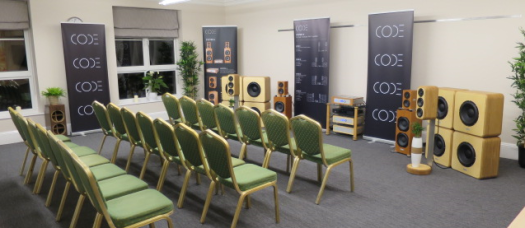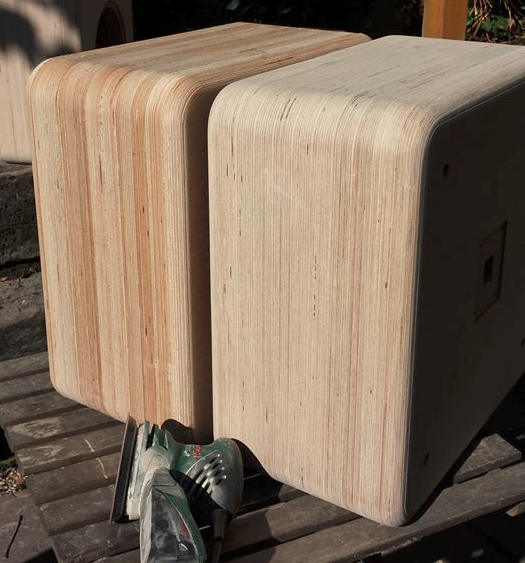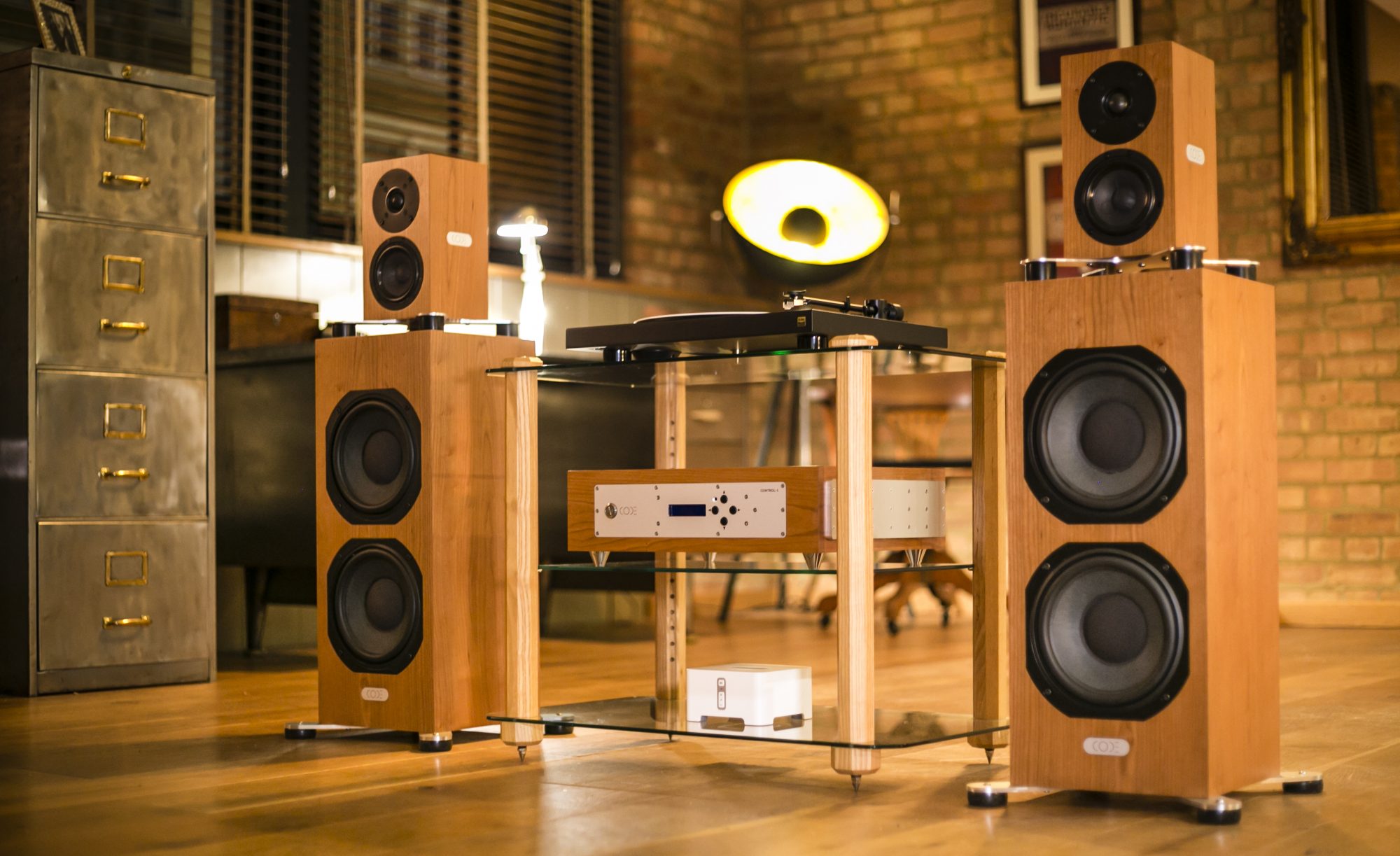Intro
Just to give a quick recap; Code Acoustics set themselves the fairly ambitious task of developing a brand new, show-stopping sound system within three months, to demonstrate at the National Audio Show last year. The final set-up can be seen below:

We were awarded the ‘Best Innovation’ prize for our modular concept, nominated for ‘Best Presented Room’, and came second in the all important ‘Best Sounding Room’ category, as judged by a panel of renowned Hifi journalists and experts within the industry.
If you haven’t checked out part one, but fancy having a look, the link is here:

SYSTEM-2 specification
Configuration: 3-way DSP controlled fully active speaker with a pair of off-board electronics modules.
Crossovers: Linkwitz-Riley (L-R) 4th order @ 250Hz and 3.5kHz
Drivers (per side):
Tweeter: 1 x Scan-Speak 1” D2905-950000
Midrange: 2 x Scan-Speak Illuminator 4” 12MU/8731T00 drivers (run in parallel)
Bass: 4 x 12” Peerless 835017 drivers
DSP: 2 x Hypex DLCP modules, daisy-chained with 12 channels of output (all used).
Amplifiers: 12 x Hypex UcD180HG HxR modules (180 watts into 4 Ohm at 1% THD)
Power supply: 4 x Hypex SMPS1200A180 (switch mode power supply)
Who are CODE?
If you’ve not heard of Code Acoustics, we’re a small, independent British Hifi company based in Woking, England. My name is Ceri Thomas and I’m the companies founder.
Below is a pic of me standing next to a prototype pair of PA speaker we developed prior to Code being founded:

These are perhaps the spiritual parents to SYSTEM-1 & SYSTEM-2!
If you would like to check out our website it’s here:
Modularity
SYSTEM-2 would contain a large number of drive units; two tweeters, four mids and eight 12″ bass drivers (total). It occurred to us that rather than putting all the drive-units in two cabinets (left and right channel), which would be fairly big and heavy, we could house the tweeter and midrange units in a little stand-mount, and then each bass driver in its own dedicated enclosure, as shown below:

This would allow a number of configuration options as shown in the diagram below. Effectively you could build a SYSTEM-2 for any size room, with the option of upscaling and downscaling as your needs changed!

Cabinets
SYSTEM-2, being a concept speaker gave us the chance to experiment with a layered cabinet construction technique. This is essentially stacking and gluing multiple sheets of your chosen material; in this case 24mm thick sheets of high grade Scandinavian plywood.

Once the cabinet is assembled, ratchet straps are employed to eliminate any air gaps between the layers, whilst the glue dries:

If it looks like these cabinets were built in a back garden… they were! By the time the CAD designs were complete, there was less than 2 months to go until the show and simply not enough time to engage with a commercial cabinet maker. Instead the woodwork was CNC cut to our specifications from dxf files similar to what you see below:

We would then assemble and finish the woodwork ourselves.
A complete BASS-2 cabinet, as modeled in CAD can be seen below. It consists of 11 layers of 24mm thick plywood, with 48mm thick front and rear baffles:

Below you can see an individual layer:

The advantage of this construction method is you can create complex 3D shapes that would be very difficult to reproduce with a traditional box construction method.
We took advantage of this by utilising a cylindrical cavity behind the bass drivers. A cylinder is one of the strongest shapes and ideal to resist the high pressures produced when the drive unit makes large excursions.
The four cavities around the central cylinder would be sand filled. This would create a high mass cabinet (30kg each!), with the advantage that the sand would dissipate a good portion of the unwanted cabinet resonance.
Once the cabinets were constructed, they were sanded down with a combination of belt sander, random orbital sander and good old fashioned hand sanding. The cabinet below left is pre sanded, and right post:

Once the sanding was completed, the cabinets were given several layers of Danish oil. This is the first coat being applied:

and after several coats:

Radiused edges and edge diffraction
There is a school of thought in loudspeaker design that sharp edged cabinets should be avoided. The rational is you can produce secondary sound sources where the sound waves emanating from the drive units hit the sharp edges of the cabinet and bounce off. This would have the effect of blurring the stereo image as your brain struggles to pick out the ‘true’ sound source. Below is an image taken from Vivid Audio’s website:

I’ve included a link to their page as it’s a nice explanation of the concept:
https://www.vividaudio.com/technologies/technologies/acoustically-designed-cabinets.html
It’s worth noting that there are also some well respected figures that disagree, saying it makes no difference. Siegfried Linkwitz is one of those and in his piece below states there is no real evidence to suggest edge diffraction does cause audible issues:
http://www.linkwitzlab.com/diffraction.htm
For what it’s worth, based on our experiments, we believe there are benefits to be gained from radiused edges; primarily in tightening up the stereo image and making sounds that fraction sharper and more detailed. We’ll actually cover this in more detail in a separate article.
But suffice to say, using layered plywood cabinets provided us with the opportunity to use radiused edges, so we took it and put fairly sizeable (20mm) rads on the front and rear baffles.
The end result
The picture below shows the end result of three months of pretty hard work! This is our SYSTEM-2 (and SYSTEM-1 on the inside) set up in the Chapel room at the National Audio Show at Whittlebury Hall:

We would have liked to have had metalwork on the BASS-2 cabinets, but we simply ran out of time. This will be rectified on our production SYSTEM-2 design.
Sound Set-up
We initially set the speakers up against the walls and the sound was… well awful! Show rooms are notoriously difficult to get a good sound from. They’re sparsely furnished and are consequently pretty reverberant. Then the walls are thin and you usually have other demonstrators doing their sound test at the same time, making an already demanding task more challenging.
Other issues are resonant frequencies of the surroundings. For example the plastic light reflectors in the ceiling seem to be particularly easy to ‘set off’ and there isn’t much you can do about it, other than avoid tracks that have those prominent frequencies!

You can see from the pic above that the SYSTEM-2 stacks are really too far apart. The problem is we needed to also fit SYSTEM-1 in and have a couple of banners. Hardly no-compromise audio!

We started bringing the whole SYSTEM-2 set-up away from the walls and every incremental 10cm sounded better. I think we were essentially removing the room from the equation. If you do this with bookshelf speakers the whole set-up can become very bass light, but with our eight 12″ bass drivers, this wasn’t too much of an issue!
In the end we settled with the speakers toe-ed in with the inside BASS-2 cabinets about 80cm from the rear wall. We would have continued to bring the set-up forward, but it may have started to look a bit odd!
Verdict
I’m very pleased the say the overwhelming response was that people really liked the sound, both journalists and audio enthusiasts.
What I didn’t anticipate was getting particular praise from professional musicians and studio engineers who seemed to all be saying variations of ‘this just sounds right’.

We received several comparisons to ATC speakers (an example below), which I’ll happily take! If you’re not familiar with ATC, they make high quality passive and active speakers comfortably spanning pro and domestic use.

We tune our speakers for a flat frequency response (or correct!), which is deemed highly desirable for pro use, and the speakers have a dry bass character. Again I’d argue the ‘dryness’ is more a reflection of the fact we don’t have artificial ‘bass boom’ that can afflict a good number of ported designs.
People also commented on how laid back, unforced and natural the sound was. My theory is that because the sound system could move such a large volume of air and had mighty power reserves, even at fairly high volumes it was just ticking over. Consequently the distortion levels were extremely low.
But anyway, that’s enough from me! I’ve include a list of the awards we won or were nominated for below, along with some of the press comments.
Show awards:
Winner – ‘Best Innovation’ (for our modular concept)
Second place – ‘Best Sounding Room’
Nominated – ‘Best Presented Room’
Press comments:
SYSTEM-2 “sounded totally effortless and very wide-band.”
Jason Kennedy, The Ear
Code Acoustics “was definitely one of the more interesting rooms”
Simon Pope, What HiFi? 8 Highlights from NAS
“One of the most interesting brands was Code Acoustics”
Alan Sircom, HiFi + NAS Show Report
“The final newcomer to Whittlebury was Code Acoustics, run by a talented young designer from Woking called Ceri Thomas, who has come up with a rather unique modular system of active electronics, control unit and speaker system that you can build up in stages as funds or desires permit. This system really interested me and impressed me greatly. My wife also loved the design principle and looks of the system. Another young company to keep an eye on”
Ian Ringstead, HiFi Pig NAS Show Report
“At National Audio Show they were primarily highlighting their SYSTEM-2 Stage 4 set up which is nothing if not impressive looking. Code were playing some rather nice electronic music from John Hopkins (Immunity) that really played to the systems strengths. The sound is, to my mind, reminiscent of a really good PA system with more refinement.”
Stu Smith, HiFi Pig NAS Show Report
“Fortune favours the lucky in the case of our visit to the CODE room. Often at shows manufacturers want to maximise their opportunity and bring perhaps too many pieces of equipment to show off during the fleeting visit of a punter/attendee. When we strolled in I’d hoped CODE could hook up there largest system as I’d heard from others in the industry that it was an interesting mechanical interpretation using popular Scan Speak drivers. Luckily when we entered the right 😉 combo was playing, the 4x woofer per side array and there competent dual mid and tweeter cabinets. This was no doubt the most effortless and unobtrusive ‘large’ room systems, playing raw without 1000’s spent on tempering the natural difficulties of the space. One could easily have erected a hammock, added a warm breeze and a couple of palms, put on some St Germain and drifted away without a sleeping aid, OK, maybe with a cocktail or 2 in hand 🌴😉🌴”
Demand Better Audio
“I really enjoyed the Code Acoustics room. The new modular system was very clever, both cool looking and sounding and we particularly enjoyed the music selection that was very electronic when we were in there. One to watch I think.”
Linette Smith, HiFi Pig NAS Show Report
Wrap up
Thanks for reading and that’s all for part 2. In part 3 we’ll take a look at the production design for SYSTEM-2. If you have any comments, suggestions or want to find out a little more, then please get in touch.
Ceri Thomas
Founder
Code Acoustics
info@code-acoustics.com


